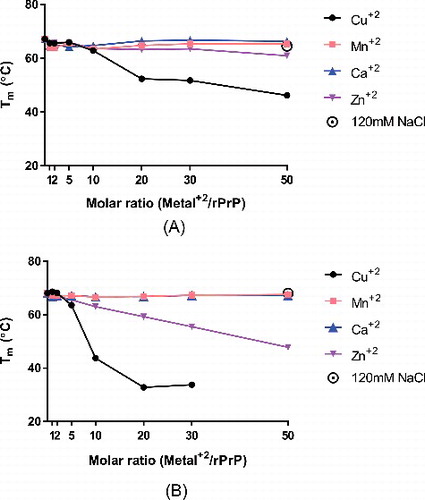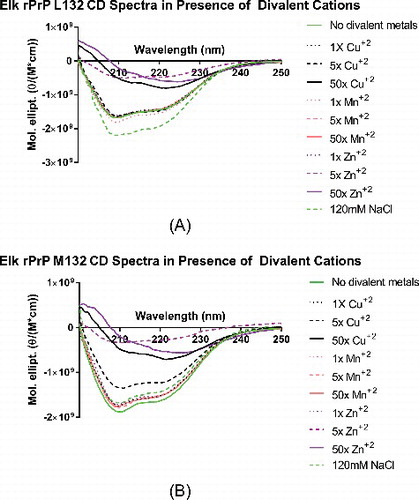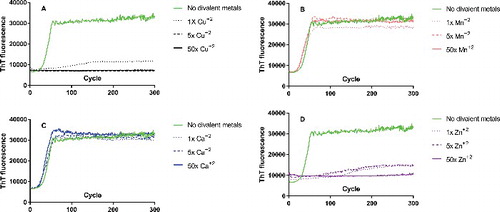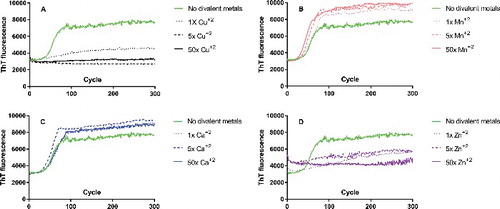Figures & data
Figure 1. Determination of Tm of Elk rPrP variants by thermal denaturation circular dichroism spectroscopy. Both rPrP L132 (A) and M132 (B) were melted in either the absence or presence of increasing molar ratios of divalent cations, copper (black circles), manganese (pink squares), calcium (blue triangles), or zinc (purple triangles). In the absence of divalents, both variants have similar melting temperatures – 67.16°C for L132 and 68.08°C for M132. The profile of M132 in the presence of 50x copper did not exhibit a sigmoidal shaped unfolding curve consistent with two state cooperative unfolding and could not be used to determine a Tm and is not included in this figure. In the presence of 120 mM NaCl, L132's Tm was 64.58°C and M132's was 68.01°C.

Figure 2. Circular dichroism spectra of Elk rPrP variants in presence and absence of increasing molar ratios of divalent cations. The far UV CD spectra of both L132 (A) and M132 (B) was determined incubated in PBS alone (solid green line), and in 1x (dotted line), 5x (dashed line), and 50x (solid line) molar ratios of copper (black), manganese (pink), and zinc (purple). Angle of deflection data was converted to molar ellipticity.

Figure 3. Real-time quaking induced conversion (RT-QuIC) of Elk rPrP L132 in presence and absence of increasing molar ratios of divalent cations. Monomeric L132 (A-D) was used as substrate and seeded with brain homogenate from homozygous L132 elk infected with CWD. Relative amounts of PrPCWD were determined by ELISA and equal amounts of seed are used as described in the Methods. Conversion of monomers into fibrils monitored by increased Thioflavin T (ThT) fluorescence (arbitrary units) as a function of cycle number are shown either in the absence (green line) or presence of increasing concentrations of divalent cations. L132 incubated with 1x (dotted line), 5x (dashed line), or 50x (solid line) molar ratios of (A) copper (black), (B) manganese (pink), (C) calcium (blue), or (D) zinc (purple). Under the conditions of the experiment, unseeded controls did not convert and, for clarity, are not shown.

Figure 4. Real-time quaking induced conversion (RT-QuIC) of Elk rPrP M132 in presence and absence of increasing molar ratios of divalent cations. Monomeric M132 (A-D) was used as substrate and seeded with brain homogenate from homozygous M132 elk infected with CWD. Relative amounts of PrPCWD were determined by ELISA and equal amounts of seed are used in both (see Methods). Conversion of monomers into fibrils monitored by increased Thioflavin T (ThT) fluorescence (arbitrary units) as a function of cycle number are shown either in the absence (green line) or presence of increasing concentrations of divalent cations. M132 incubated with 1x (dotted line), 5x (dashed line), or 50x (solid line) molar ratios of (A) copper (black), (B) manganese (pink), (C) calcium (blue), or (D) zinc (purple). Under the conditions of the experiment, unseeded controls did not convert and, for clarity, are not shown.

